Blog / Understand Italians

Understand Italians
Bel Paese (Beautiful country) – how Italians call their country
Italy is a beautiful country, often visited by tourists and businessmen; therefore getting to know the cultural profile of Italians will facilitate building business relations and contribute to a better understanding of the society and its national culture. The proverb often quoted by me at the intercultural workshops “When in Rome, do as the Romans do” is an explicit invitation to familiarize you with the business culture of Italians.
Italian culture of relations
The Italian proverb saying, “The family is the best that God has given,” reflects importance of family for Italians. They put a lot of attention to maintain good familiar relations. A family includes parents, siblings and children, but also other cousins and relatives; they support each other in business and life. Sometimes this mutual support may be a problem for people who do not belong to the family, when in business situations people who know themselves are preferred over those who have the appropriate competences. This phenomenon is called nepotism, the term derived from the Italian word “nipote”, meaning grandson. A word ‘raccomandato’ which means referred person is often used in Italian social life.
In Italian corporations, people build horizontal relationships; they are called “cordata”. The word denotes a group of climbers in the mountains linked by a safety chain. Knowing about the importance of relations in the functioning of Italians, when working in Italy it is worth spending enough time to build good relations.
.
Deal-focus and relationship-focus business cultures
Due to the way business relations function, there are two types of cultures – a deal-focus and a relationship-focus cultures (R. Gesteland model). Societies belonging to relationship-focus cultures prefer to do business with people they know, which is why building relationships is so important for members of these societies.
Italy belongs to this culture. In the case of the deal-focus culture, its representatives do not attach so much importance to the fact that they only do business with people they know, because the main goal of a business relationship is a transaction. The USA and the Netherlands belong to transaction cultures. In this dimension, Polish culture is referred to as dual, as Poles exhibit behaviors typical of both the deal-focus and relationship-focus cultures.
A society of relationship-focus culture characterized by intense social relations that should be nurtured and supported by social interactions. The best opportunity is to eat together. It is no coincidence that relationship-focus cultures such as China, Japan, France or Italy have a highly developed food culture and the best cuisines in the world. In the case of Romanesque cultures – France and Italy, relationships are maintained through frequent conversations and discussions. Italians talk everywhere – the driver driving the coach, he can talk on the phone all the way (2 hours), passengers on the train talk continuously to each other or on the phone.
People stop in the street to talk to each other (I rarely see such scene in Poland).
What does this mean in business?
In business, the relationship-focus culture is reflected in the fact that Italians prefer to do business with people they know or have been recommended to them. In the case of team work, trust in the new person is built over a longer period of time, because Italians belong to a culture where trust is built on the basis of a relationship, as opposed to a deal-focus culture, e.g. in the US, where trust in a person is built on the basis of the competences a person has. The differences in organizational behaviour between the two types of cultures can be summarized by saying “I trust a person I know” in a relation-focus culture versus „I trust a person who is competent in a deal-focus culture”.
Italians’ affective way of communicating
Italians like to be in touch, also in the literal sense of the word. While talking, they gesticulate; may touch the interlocutor, the distance between people who are standing and talking is definitely smaller than, for example, in Poland or in Anglo-Saxon cultures, as Italy belongs to affective cultures in which showing emotions is the cultural norm. Poland with little body language and showing no emotion belongs to a moderately affective culture. This means that we are more emotional in communicating than, for example, Finns (belonging to a neutral culture), but less affective than Italians.
It is worth to know these two cultural dimensions that define the way the people in different cultures communicate, and consider them when interpreting their communication. Human nature is to interpret what they encounter in international relations through their personal experience (which may be limited) and through prism of it own (national) culture – all these may lead to misinterpretation and misunderstanding.
For example a behaviour of interrupting or overlapping statement of an interlocutor during a conversation, is a norm in an affective cultures and reflects expression of the interlocutor’s commitment but may be considered rude in a neutral culture.
Italians, with their dynamics, expression and commitment to the conversation, are excellent interlocutors, so it is worth appreciating it.
Particularistic culture of italy
Culture researchers F. Trompenaars and Ch. Turner-Humpden distinguished two types of cultures due to their attitude to obeying the law, rules and principles: universalistic and particularistic. In the first one – its representatives, when they have a dilemma to favour the law or relations when deciding how to behave in a specific situation, are guided by the law and observance of procedures in their actions. In universalistic cultures, it is believed that law and principles are the equal for all, and should be obeyed by all. Representatives of particularistic cultures believe that the law should generally apply, but in their (particular) case or their friends’ case it can be interpreted in their favour.
In Polish culture (being particularistic), this attitude is well defined by the proverb “If Kali steals it is good, if Kali has been stolen is not good”. Italians also belonging to particularistic cultures have a proverb “Fatta la legge, trovato l’inganno” which can be translated as “Every law can be circumvented”.

A sign in Florence Photo Wiola Małota
In Florence, they are jokes about the style of car driving claiming that drivers consider the red light as “a suggestion”. I personally did not notice such style of driving of Italian drivers; I was even surprised at the correct distance between the cars on the highway and the smooth driving. I even consider the driving style of Poles to be more “fancy” (Poland also belongs to a particularistic culture).
Particularism in everyday behaviour may mean that people for the sake of relationships are telling white lies. An example of such an attitude is the protagonist of the film directed by Roberto Benigni, “Life is Beautiful” (awarded with 3 Oscars), who, in order to protect his son from pain and fear during his stay in a concentration camp, shows him life in the camp as a form of a scout camp.

Pinocchio, a character from an Italian fairy tale Photo Wiola Małota
Italians – individualistic culture
Fare bella figura means Look beautiful
Italians are great individualists, everyone wants to emphasize their individuality (for example in clothes) and express their opinion (long and engaged discussions). Italian culture is classified as an individualistic culture. We will understand this when we turn to the history of Italy. Until 1861, when Italy was founded, there were city-states that wanted to retain their individuality and regionalism after unification. Each of the 7 countries that made up Italy had different legislation, currency, language and customs; therefore one of many examples of individualism of Italian society is a strong identification first – local, then regional.
Italians like their regional cuisine, speaking in a dialect is not a shame and they nurture the local identity. In the study of the cultural dimensions of G. Hofstede, in the dimension of individualistic and collectivist behaviour, Italy on a scale from 1 to 100 (the greater the number of points on the scale, the more individualistic and less collectivist culture is) obtained a high score of 76 points. (Poland 60).
Italians – individualists who like group life
The Italian cultural profile regarding individualism is unique – Italy is relationship-focus culture (also referred to as a relational culture), in which building and maintaining social relations is the basis of functioning in society, but as the same time is also characterized by a high level of individualism. In general, relational societies exhibit collectivist behavior (such as South Korea, China, and Japan, for example) however Italy is an exception to this rule. For Italians it is important to belong to social groups that allow them to benefit from mutual support but at the same time want to distinguish themselves in this group, for example by different appearance.
Joy of life – La dolce vita
Italy is famous for its fine arts – architecture, sculpture, painting, poetry, theater and opera created since ages. Even landscape is national treasure and is protected by law. The beauty of human and nature’s creation surrounds Italians so they can enjoy it every day. Italians love culture and appreciate it – the offer of art exhibitions is amazing, there are a lot of parks with open-air sculptures. Italian food is healthy and tasty they savor their meals and meetings with family and friends, making everyday life beautiful.

Coffee in Milano Photo Wiola Małota

Spiritual and material treasures of Italian culture in miniatures Photo by Wiola Małota
Pragmatism, Creativity and Innovation of Italians
The researcher of national cultures G. Hofstede using the criterion – approach to the unknown situation and to change – distinguished two types of cultures: cultures open to change, unknown and otherness (called cultures with a low level of avoiding uncertainty) and cultures closed to otherness and change (these cultures are characterized by high degree of avoidance of uncertainty). The separate principalities (which later are unified into Italy), traded with exotic countries, Italians have always functioned in a diverse environment – many regions, languages and dialects, and therefore it is easier for them to accept ambiguous and new situations and otherness. This contributed to high level of societal tolerance and openness of Italians.
It manifests itself also in pragmatic approach to what Italians encounter by accepting ambiguity of situation. An example is the attitude towards Garibaldi, who is cherished even though he is not a crystal hero. Italians are not “zero-one” in their opinions; they accept the complexity of the situation. Perhaps this is one of the factors contributing to their longevity – a flexible approach to life, acceptance of change. The acceptance of change is also expressed through its creation. Italians are known for their creativity and innovation. Art, Italian design and Italian fashion are known and appreciated all over the world.
The level of uncertainty avoidance is shaped also by the unfavourable events caused by nature happening in life of societies like – earthquakes, earth shifts, and floods. As they happen quite often in Italy, they contribute to higher lever of uncertainty avoidance index. When taking into account these two factors together Italians express middle high level of uncertainty avoidance (UAI) of 75.
For comparison the USA and the Great Britain have low UAI (35 and 46 respectively) – 35 UAI, while Poland and Greece belong to the countries with the highest UAI (93 and 100 respectively).

Solar miniauto, an example of creative and innovative mind Photo Wiola Małota

Example of creativity of branding of common pepperoni

Example of creative mind and tolerant, peaceful approach of Italians Photo Wiola Małota
Dr Wioletta Małota

The author is a Intercultural Trainer and Consultant delivering training of intercultural management, intercultural negotiations and global marketing. She specializes in the cultures of Italy, Germany, France, the Netherlands, Scandinavian, Anglo-Saxon, Ukraine and Confucian countries (South Korea, China, Japan). She has published the book on South Korea (in Polish).
Likes travelling to different cultures to learn them and to photograph modern architecture. She is a fun of cinema (especially Korean and Italian), loves art and nature. She likes telling the stories from their journey in form of photo stories at her page www.crossculturemanagement.online.